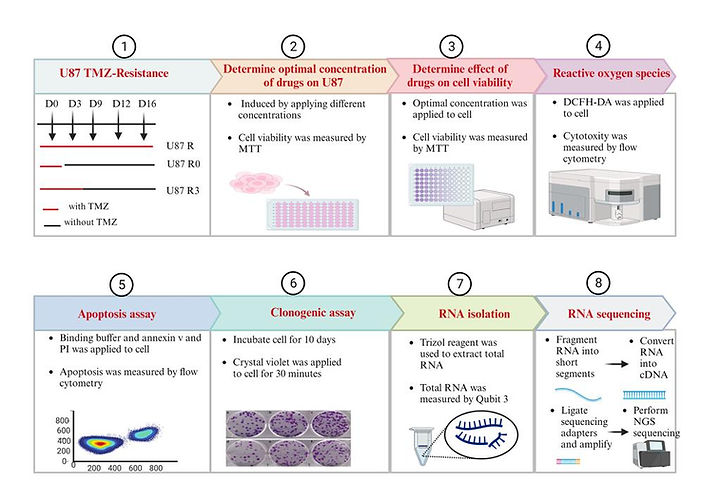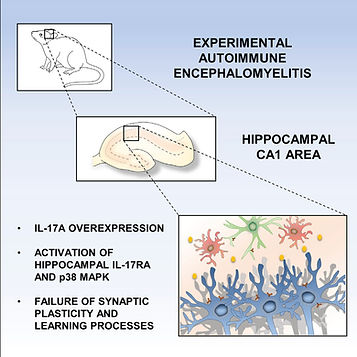Current Projects

Enhancing Temozolomide Activity by Targeting NADPH and ROS Formation with Thionicotinamide and Sanguinarine in Glioblastoma Cells
This project is supported by TUSEB (Project No: 31408)
Reactive oxygen species (ROS) are crucial for cell signaling and homeostasis, particularly in cancer cells reliant on ATP and NADPH. These cells have an elaborate antioxidant defense system, involving NADK for NADPH production and NOXs utilizing NADPH for biosynthesis reactions. In cancer, NADPH levels significantly rise, impacting growth and survival. Targeting NADPH metabolism, particularly with NADK suppression, shows promise in inhibiting cancer cell proliferation. Moreover, NOX enzymes, prevalent in various cancers, induce apoptotic cell death by elevating ROS levels. A study aims to enhance temozolamide (TMZ) sensitivity in glioblastoma using Sanguinarine to increase ROS and Thionicotinamide to diminish NADPH, potentially improving treatment outcomes.

Identifying Novel IL-17A Inhibitors from Small Molecule Databases and Investigation of Their Effects on Suppression of Inflammation in Multiple Sclerosis by In Vitro and In Vivo Methods.
This project is supported by TUBITAK 1001 (Proje No: 123S075)
The aim of our study is to identify drug candidates targeting IL-17A and small molecules that have the potential to structurally inhibit IL-17A by in silico and drug repositioning studies. The most important original value of our study will be the detection of these new molecules and the evaluation of their activities. The experimental methods to be followed are as follows: Molecules with the capacity to inhibit IL17A will be determined from approved drugs and small molecule libraries through in silico studies. The efficacy of candidate inhibitors to inhibit IL-17A will be investigated by screening studies at the molecular and cellular level. Structural biology studies and binding modes of the most effective molecules in the target structure will also be investigated in in vitro studies. In addition, by creating an MS model with cuprizone in C57B6 congenic mice, it will be observed whether the determined IL-17A small molecule inhibitor suppresses inflammation in the MS model, how much it inhibits demyelination in MS pathology and whether it increases remyelination.
The project proposal consists of 4 main work packages. In the studies to be carried out by Bahçeşehir University (BAU) Faculty of Medicine, Dr. Serdar Durdağı (BAU Biophysics) will be responsible for the in silico parts of the project. Dr. Fatih Eren will contribute to the research in cytokine analyzes and other in vitro analyzes in the study (Marmara University, Faculty of Medicine). Structural biology studies were conducted with the Turkish Light Source X-ray diffractometer at the University of Health Sciences and Dr. The interaction of target protein and candidate inhibitors will be solved under the leadership of Hasan Demirci; The effect of inhibitors on the target protein will be examined.

Discovery of novel combined chemotherapeutic in TMZ resistance glioblastoma
This project is supported by Bahçeşehir University Scientific Search Project (BAP, Proje No: 2021/1)
New in vitro models of acquired TMZ resistance were generated to examine the molecular features of therapy resistance in GBMs. Transcriptomic differences between TMZ-resistant cell lines and combinatorial drugs were examined by RNA sequencing, which revealed major alterations in the resistant cell populations. To top it all, this study is the first study in which three chemotherapeutics with DNA binding properties were used together and Epirubicin was used against drug resistance in glioblastoma. Thus, although further in vitro and in vivo assessments are required to investigate the anti-tumor underlying mechanism of the combination of Temozolomide, Epirubicin, and 5-Flurouracil therapy, this data add new evidence that combination treatments have a role to play as a therapeutic target in glioblastoma.

Investigation of SUSD6 on AKT and STAT3 pathways in atypical meningiomas
SUSD6 is a type I membrane protein consisting of 303 amino acids. The SUSD6 gene harbors somatic mutations in different tumor tissues. While in glioma tumors, it's been noted that SUSD6 mRNA levels are lower compared to normal brain tissue, and overexpression of SUSD6 suppresses glioma cell proliferation and angiogenesis, rendering AKT and STAT3 signaling pathways inactive and promoting apoptosis. For the targeted treatment of atypical meningiomas, it's essential to investigate new target genes or proteins that can be used in treatment strategies and to develop new therapeutic options. Our preliminary in silico studies have revealed that as the evre of meningiomas increases, SUSD6 levels decrease, and in patients with decreased SUSD6 expression, higher recurrence rates were observed. Moreover, analysis of transcriptome data from databases indicates a correlation between SUSD6 expression and AKT and STAT3 pathways, which are significant regulators of cell proliferation and angiogenesis. The project proposal aims to explore the regulatory role of the SUSD6 gene on the AKT and STAT signaling pathways in meningiomas and its effects on tumor development. Planned in vitro studies will investigate the impact of high and silenced expression of the SUSD6 gene on the tumor's angiogenic potential, migration and invasion capacity, and apoptotic effects. Additionally, its effect on the AKT and STAT3 pathways will be evaluated through the expression of key genes within these pathways. Analyses of SUSD6 levels in different stages of primary meningioma tumors and analyses of genes related to these pathways will be performed using tissues obtained from patients. Comparative analyses will be conducted between tissues from recurrent patients and tissues from primary and recurring meningiomas to further understand these associations.

Evaluation of the role of three novel prognostic regulatory axis in tumorigenesis and GBM progression
Investigating role of LncRNAs in tumorigenesis and GBM progression: focusing on the microRNA and the related gene axis. Due to the lack of deep undress of the molecular mechanisms involved in the pathogenesis of the GBM, the median survival rate has remained around 15 months. The results suggest that these regulatory axes probably play an important role in GBM pathogenesis and progression. Targeting them may be a promising approach for the treatment of GBM patients.
She is using invitro models to validate her hypothesis.


Epigenetic consequences of MAT2A inhibition and methionine restriction on glioblastoma cell lines
This project is supported by TUBITAK 2209-A (191B012307293)
MAT2A catalyzes the rate limiting step in methionine cycle and also leads to formation of universal methyl donor S-Adenosyl Methionine (SAM). Anti-cancer effects regarding MAT2A inhibition already shown in other cancer types such as Lymphoma. In this project, we aim to evaluate the promoter methylation status of promoter- hypermethylated tumor supressor genes in glioblastoma cell lines by inhibiting MAT2A and applying methionine restriction.


Investigating the Therapeutic Potential of IL-17 Inhibitors on Cognitive Impairment, Mood Regulation, and Motor Function in a Cuprizone-Induced Mouse Model of Multiple Sclerosis
Project aims to investigate the potential impact of candidate drugs on cognitive and behavioural changes in a cuprizone-treated mouse model of multiple sclerosis (MS). Initially, mice will be administered cuprizone to mimic the MS disease. Subsequently, these mice will receive specific candidate drugs, and we will assess changes in both brain structure and function. Our methodology involves a combination of histological and immunohistological methods to measure key factors such as BDNF, MBP, dopamine, and serotonin levels in the brain. Additionally, we will employ maze and behavioural tests to evaluate cognitive qualities, including spatial memory, anxiety, and depression. The goal of this study is to determine whether these repurposed drugs could serve as potential candidates for improving cognitive impairments in MS patients.

Investigating the use of E2F3 gene silencing by microRNA-449a as an anti-cancer therapy in glial cancer cells.
This project is supported by TÜBİTAK 2209-A Program and BAUTTO (Project No: 1919B012205914)
This study aims to explore the anti-cancer properties of glioma cell lines (LN18, U87-MG) through the modulation of E2F3 gene activity using microRNA-449a. The gene sequence of miRNA-449a will be obtained from Macrogen, and cells will undergo transfection with varying concentrations under different conditions. Post-transfection, the expression of miRNA-449a in cells will be analyzed to inhibit the target gene E2F3 post-transcription. Subsequent analyses will investigate the impact of miRNA-449a on cell proliferation and viability, DNA repair, and its correlation with cell cycle phases in the specified cell lines.

The Relationship Between Low Cancer Incidence in Huntington Patients and CBP/β-Catenin Pathway
This project is supported by TUBITAK (Project No: 1919B012305077)
Past studies have shown lower rates of cancer among Huntington patients, and there has not been a sufficient explanation given to why that might be. Therefore, Atilla hypothesized that it might have something to do with mutant Huntingtin (the protein responsible for Huntington's disease) binding to certain proteins that wild-type Huntingtin does not. He aims to represent the relation by conducting in vitro studies on cancer cell lines.

Dual inhbition of IDH1 and XPO1 in gliomas.
The aim of the study is to evaluate the effects of the combination therapy of mutant IDH1 inhibitor ML-309 and XPO1 inhibitor Selinexor in glioma cell lines and further investigate the mechanisms behind it.
Completed Projects
Thesis Projects

